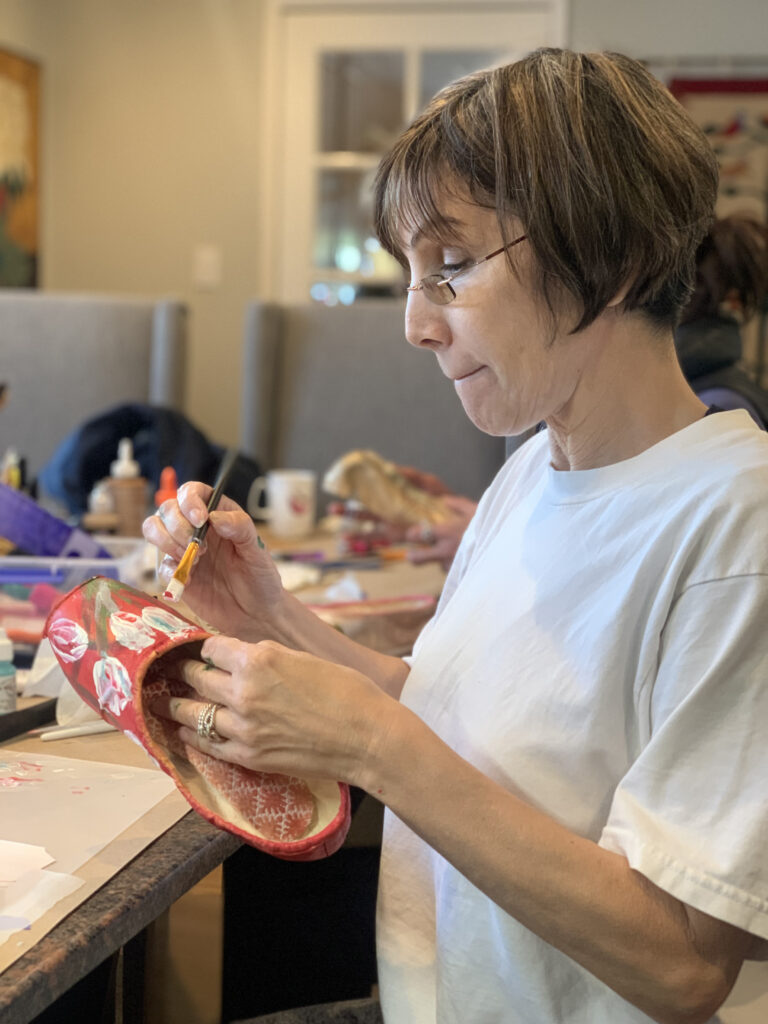How Artists are Keeping Mountains of Dead Pointe Shoes Out of Landfills
[ad_1]
Pacific Northwest Ballet goes through roughly 2,000 pairs of pointe shoes per year. New York City Ballet uses 500 pairs per month during Nutcracker season. Some pros exhaust multiple pairs of shoes in a single performance day.
Stats like those raise a big question: After the shanks have collapsed and the boxes have turned to mush, where do all the dead pointe shoes go?
According to Ozgem Ornektekin, a mechanical engineer who specializes in sustainability, a pointe shoe as a whole can’t go into a recycling waste stream. It needs to be pulled apart to salvage individual materials: The box and sole can go into paper and cardboard recycling streams, while the nails in some shoes can be recycled with metals, but the fabric needs to be donated to local fabric recycling collection boxes. The entire process of deconstructing the shoe is difficult, expensive, and time-intensive—which is why, unfortunately, most pointe shoes end up in landfills.
But some people and organizations are working valiantly to keep shoes out of the trash. Here are three ways dead shoes are getting a more environmentally friendly second act.
Shoe Souvenirs
The most common way companies repurpose pointe shoes is through signed-shoe sales. Many sell dancer-signed pairs in their gift shops, or send them as thank-you gifts to those who contribute to company pointe shoe funds.
During Pacific Northwest Ballet’s Nutcracker season, young students who participate in the production have the chance to write letters to company members they admire, and request a signed pair of pointe shoes from them. “That’s very popular,” says Sandy Barrack, PNB’s production stage manager.
The company also offers old shoes to the young children in its Eastside Summer Workshop for crafting purposes. And every so often, “someone will ask me for pointe shoes so they can make a wreath out of them, and things like that,” Barrack says. “I try to make use of the ones that can’t be sold when I can.”
Creating Art
Dead pointe shoes have also been used in professional artwork. The artist Karon Davis featured a small mountain of pointe shoes in her ballet-themed exhibition, Beauty Must Suffer, at New York City’s Salon 94 last fall. Davis’ mother, who like Davis was a dancer, sourced the shoes from thrift stores and estate sales; the installation gave them a poetic second life.
At Leigh Purtill Ballet Company, dancers turned their old pointe shoes into detailed floral centerpieces for the company’s spring gala. “The theme was ballet in bloom, and I wanted to incorporate pointe shoes,” says Vivian Garcia, a dancer and member of the company’s production team. She asked the other performers to save and donate their old shoes. “We were immediately bombarded,” says fellow dancer and production team member Elena Castellanos. Many dancers contributed—including one who had kept every pointe shoe she had ever worn—and in the end the production team had roughly 50 pairs to work with.


A team of four company members came together to bring Garcia’s vision to life in her mother’s backyard. “We painted flowers onto the shoes, put beautiful pieces of fabric both inside and outside of the soles of the shoes, and used shimmery paint to give it a glow,” Garcia says. Then the company raffled the shoes off as part of the gala’s fundraiser, helping to raise $5,000, which went toward their production of The Nutcracker and other expenses.
“I care a lot about the environment, and it’s been hard for me to go through so many shoes so quickly,” Castellanos says. Garcia agrees: “I think it’s wonderful for our pointe shoes to have this second phase of life.”
Recycling and Upcycling
Despite the difficulties, there have been various efforts over the years to recycle pointe shoes—or upcycle them.
Ornektekin founded Petit Pas New York, which transforms old pointe shoes into leather and satin accessories, after learning about how many pointe shoes professionals and advanced students were flying through. Partnering with the School of American Ballet (and with shoe maker Freed of London’s support), Ornektekin dissected students’ pointe shoes to determine what materials could and could not be reused. Then, with her team, she created four products: three bracelets and a small coin/hairpin bag. “We used the leather at the front of the shoe to make bracelets, and the satin from the back of the shoe to make bags,” she says.



All of the dead pointe shoes that Ornektekin revitalizes come from students at SAB. “At the end of each semester we get a big dump of them, and everything gets sanitized before we use it,” she says. Beyond what Petit Pas is doing for the environment, 50 percent of their proceeds goes back to the school’s pointe shoe fund to reduce the cost of shoes for the students.
Consider asking your school or company if they offer opportunities to donate or recycle. Though Ornektekin says her current priorities are local, she recommends that dancers around the world look into ways in which they, too, can reuse pointe shoes in their own community.

















